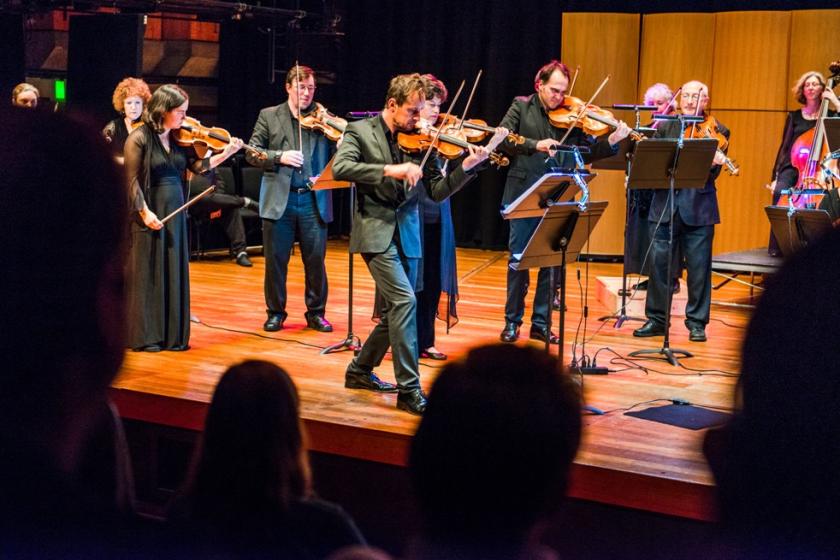As I sat, engaged and occasionally charmed but not always as impressed as I’d been told I would be, through violinist-animateur Richard Tognetti’s lightish seven-course taster menu of string music with the Orchestra of the Age of Enlightenment, it was worth bearing two things in mind. One was that this happened to be merely the official zenith of a truly enlightened three-part project; on Monday, parts of the programme had been played first to educate all ages and later to grab a young audience in more relaxed mode as part of the OAE’s pioneering Night Shift series. The other qualification was that since I sat only three rows back from the six first violins, I was never going to hear the strings as an ideal body; so perhaps it might not be fair to judge the sound.
Under the circumstances, the ensemble seemed to be remarkably tight and cohesive in the classical first half of the programme, much less so in the late-romantic second – until, that is, we came to a substantial encore. The trip-wires were mostly set by Tognetti’s own extreme flexibility and febrile involvement. He’s an elegant violinist, but as soloist in Haydn’s potentially rather ordinary C major Violin Concerto he seemed off string occasionally, and a flagged-up attempt to hit a high note in the cadenza fell flat, because sharp. My intense young violinist companion for the evening didn’t like the romantic portamenti either, though I had no problem with those, and any minor flaws could be forgiven for the time-suspending purity of Tognetti’s long line in the pizzicato-accompanied slow movement (actually a simple song, but simplicity can have its place).
 There was absolute unanimity in one of those divertimenti which, as W H Auden put it, the young Mozart wrote “to play while bottles were uncorked,/ Milord chewed noisily, Milady talked”. The silence which Auden excoriated was at least unsolemn, with as many smiles in the audience as among the players executing the deft tricks of the finale where originality breaks through rococo manners. The even more precocious (in other words, an astounding 12- to 14-year-old) Mendelssohn, turning mock-Sturm und Drang B minor into effervescent charm, came off brilliantly, too.
There was absolute unanimity in one of those divertimenti which, as W H Auden put it, the young Mozart wrote “to play while bottles were uncorked,/ Milord chewed noisily, Milady talked”. The silence which Auden excoriated was at least unsolemn, with as many smiles in the audience as among the players executing the deft tricks of the finale where originality breaks through rococo manners. The even more precocious (in other words, an astounding 12- to 14-year-old) Mendelssohn, turning mock-Sturm und Drang B minor into effervescent charm, came off brilliantly, too.
It took Elgar in elegiac mode after the interval, yoked skilfully to Tognetti’s arrangement of Grieg’s "Poème érotique" from the Lyric Pieces, to inject a serious note. Here in Sospiri, though, Tognetti was too impetuous, pushing beyond his fellow violinists near the start and not allowing the music to settle to the righ introspection It seemed a bit too vibrato-free, something that Roger Norrington has always encouraged – wrongly, I think – in leading the OAE through these kind of scores. So I came home to try out Elgar’s own conducting of his string pieces – sadly Sospiri isn’t among this vast recorded output – and of course there’s a warming vibrato there, and a much deeper introspection. But again I could blame the apparent lack of that here on third-row closeness, which most affected Dvořák’s fabulously inventive Serenade for Strings. Still, even at close quarters it was possible to admire the second violins’ heartfelt swell in the second theme of the vivacious scherzo, the poise maintained in the sentimental Larghetto, the violas' deft elaboration of the very Czech dance tune in the finale.
Best of the late-romantic fare, surprisingly, came right at the end in an unadvertised pretext for bringing back to centre-stage the harpist in the Grieg and Elgar, Tanya Houghton. Tognetti rehearsed for the audience the fact that Mahler always conducted the Adagietto from the Fifth Symphony at around the seven-minute mark as opposed to the 11-plus standard today. Though I don’t buy his assertion that it can ever sound “suicidal”, the undoubted lovesong quality comes through more ardently at the faster speed. And this was actually perfect in its rubato (and even a certain amount of warming vibrato, unavoidable here despite what Norrington might say). The OAE has had quite some experience in Mahler now, so this time the players caught the idiom to perfection. And though we missed the magical horn call that follows the dying fall, the long silence in the hall at the end spoke different volumes.














Add comment